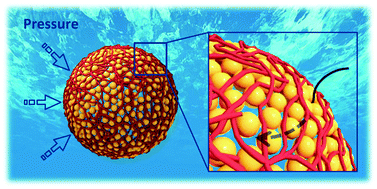Structure and elasticity of composite nanoparticle/polymer nanoshells (hybridosomes®)†
Abstract
Our group recently introduced a new process to synthesize nanoparticle shells of about 100 nm, named “hybridosomes®”. Here, the structure and mechanical properties of hybridosomes® made from iron oxide nanoparticles and poly(acrylic acid) are characterized using TEM, AFM and an osmotic compression technique. For the latter, the size distribution of the hybridosomes is monitored by nanoparticle tracking analysis (NTA) in the presence of poly(ethylene glycol)s of different molecular weights. It is found that the size of the hybridosomes® can be tuned from ca. 80 nm to over 110 nm by adjusting the amount of nanoparticles and that their shell consists of a single layer of nanoparticles, with a porous structure. The size of the pores is estimated from osmotic compression experiments at ca. 4000 g mol−1. The mechanical properties are measured both at the ensemble level using size measurements under osmotic pressure and at the single nanoparticle level by atomic force microscopy nanoindentation. Both osmotic and AFM experiments are analyzed in the framework of the continuum elastic theory of thin shells and yield a value of Young's modulus of the order of MPa.



 Please wait while we load your content...
Please wait while we load your content...